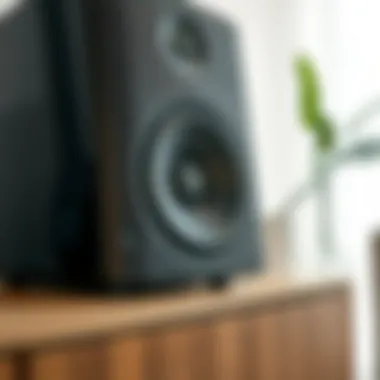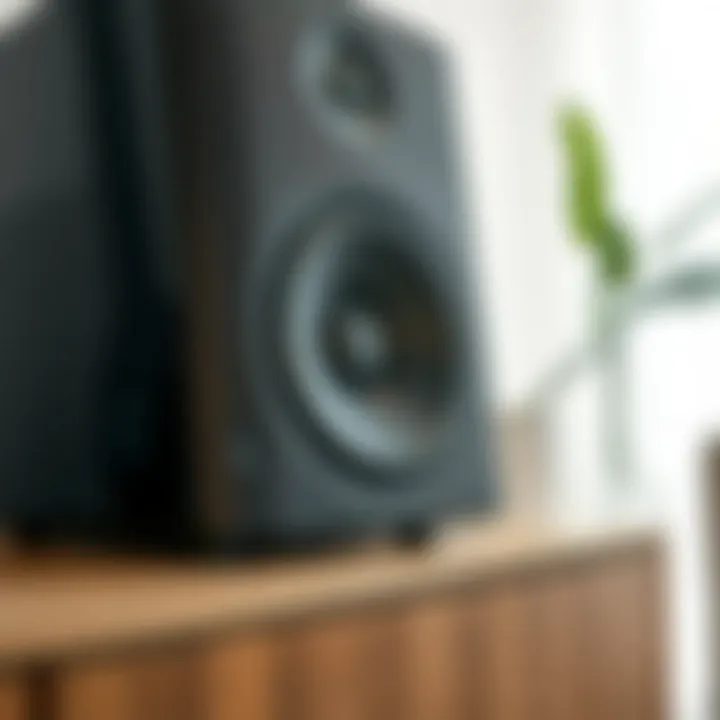Exploring Wireless Living Room Speakers: A Complete Guide


Intro
In today’s tech-forward world, the ability to integrate audio seamlessly into our living spaces has never been more significant. Gone are the days when large, clunky speakers dominated the landscape of home audio systems. Instead, wireless speakers have emerged as the go-to solution for homeowners, designers, and audiophiles alike. They not only bring convenience but elevate the art of sound diffusion into aesthetic design, fitting beautifully into modern homes.
The evolution of wireless technology has transformed the experience of entertainment in our living rooms. Gone are the tangled wires and complicated setups. With a flick of a switch or a tap on a screen, listeners can immerse themselves in crystal-clear sound without compromising on style. This guide will peel back the layers, offering insights into the benefits of wireless living room speakers and how to optimize their utilization within your space.
Deciding on the right audio solution involves understanding various aspects—ranging from innovative design trends to practical, hands-on buying guides. This narrative will provide a comprehensive look at the realm of wireless speakers, illustrating not only what makes them essential but how to select the best fit for your needs. Whether you are a homeowner envisioning a chic sound experience or a designer aspiring to inform clients, this guide will equip you with the knowledge to navigate the wireless audio landscape.
Prolusion to Wireless Living Room Speakers
In today’s fast-paced world, where technology evolves at lightning speed, wireless living room speakers have emerged as a significant player in the audio landscape. The appeal of these devices lies not just in their ability to produce sound but also in their versatility, convenience, and seamless integration into modern home environments. For homeowners, designers, retailers, and audio enthusiasts alike, understanding the intricacies of wireless speakers is key to optimizing sound experiences in living spaces.
The rise of wireless technology has transformed our interactions with music and multimedia. Gone are the days of tangled wires and strict placement protocols; now, sound flows freely through the air and can be enjoyed wherever one pleases. With numerous options available, selecting the right speakers can be a daunting task, especially considering factors such as audio fidelity, room acoustics, and connectivity.
Benefits and Considerations
- Convenience: Wireless speakers provide the freedom to place devices without worrying about cable lengths or proximity to power outlets, allowing music to be enjoyed anywhere from the kitchen to the patio.
- Versatility: Many modern wireless speakers can connect to various devices, including smartphones, tablets, and smart TVs, making them incredibly adaptable for various media.
- Aesthetics: These speakers often boast sleek designs that complement contemporary interiors, appealing to the aesthetic sensibilities of modern homeowners.
However, one must also consider challenges associated with wireless speakers. Signal interference, battery life issues, and potential sound quality discrepancies compared to wired models are potential drawbacks that require careful examination. Addressing these concerns can enhance the overall listening experience and maximize the benefits that wireless technology offers.
Understanding the Technology Behind Wireless Speakers
The tech behind wireless speakers is as vital as the notes they play. Understanding this technology is not just for the audiophiles or tech geeks; it's beneficial for anyone looking to enhance their audio experience in their living room. Grasping the ins and outs of wireless communication protocols, battery management, and innovative features provides deeper insights into why certain speakers perform better than others. It’s also about how these advanced technologies can transform the way we listen to music, watch movies, or even engage with video games.
Wireless Protocols and Standards
Wireless speakers utilize a variety of protocols to send sound waves from source to speaker. Understanding these can help homeowners or enthusiasts select a system that suits their lifestyle and aesthetic.
Bluetooth
Bluetooth technology revolutionized wireless audio by making it convenient and straightforward. It's a go-to choice for those wanting to connect their devices without cable fuss. One of the most appealing characteristics of Bluetooth is its universal acceptance—almost every modern device supports it. The major perk here is its simplicity; pairing two devices takes moments. However, it’s worth noting that Bluetooth has limitations in range and sound quality compared to some higher-end protocols. The codec used can greatly influence the audio clarity.
WLAN (Wi-Fi)
WLAN, or Wi-Fi, goes a step further by allowing for higher bandwidth, which translates into better audio quality. This protocol can transmit several channels of audio at once, making it ideal for multi-room setups. It’s a solid choice for those who seek rich, immersive sound when enjoying music or movies. A unique characteristic of Wi-Fi is its ability to maintain a strong connection over long distances. But, if Wi-Fi networks are congested or if a weak signal is present, there can be disruptions in sound quality, which can be a vexation if you have a sprawling house.
AirPlay
AirPlay embodies Apple's approach to wireless audio streaming. It lets you stream audio and video seamlessly within the Apple ecosystem. The standout aspect of AirPlay is that it operates over your Wi-Fi network instead of Bluetooth. This movement helps to maintain the integrity of sound quality, which often suffers on Bluetooth connections. One of its important advantages is that it supports higher bitrate audio files, offering a clearer listening experience, especially for music lovers. Nonetheless, AirPlay is restrictive to the Apple products; if you’re mixed with devices, you might find it a challenging fit.
Battery and Power Management
In a world where everyone's on the go, battery management in wireless speakers is a critical factor. The convenience of cord-free living hinges on understanding how to manage and maintain power efficiently.
Rechargeable Batteries
Rechargeable batteries are a staple in wireless speakers. One of their key features is convenience; no one wants to keep buying batteries. They can be charged easily, and many models now come with extended battery life, allowing hours of continuous playback. On the downside, the lifespan of rechargeable batteries can dwindle over time, sometimes leading to issues with performance if not replaced periodically. Ensuring that you maintain these can save you from unexpected outages during crucial moments like movie night.
Power Consumption
Power consumption is another crucial aspect to consider. It reflects how energy-efficient a speaker box will be over time. Many modern speakers are designed to consume minimal power while delivering top-notch performance. This competence can significantly lower your energy bills, making it a worthwhile consideration for eco-conscious users. However, be aware that battery performance can dip during high-output scenarios; the more power needed, the quicker the battery runs dry.
Energy Efficiency
Finally, the concept of energy efficiency in wireless speakers ties closely to both sustainability and cost-effectiveness. Energy-efficient speakers can operate on lower wattage, yet deliver robust sound output. They often have features that help conserve power, such as automatic sleep modes. It’s not just good for the planet; it helps maintain your wallet too. Importantly, while choosing a speaker based on energy efficiency can be beneficial, always check user reviews to ensure sound quality isn’t sacrificed for energy savings.
"Understanding these technological fundamentals can help elevate your listening experience, placing you a step ahead in the quest for the perfect audio setup."
The Advantages of Wireless Living Room Speakers
In today's modern homes, the shift toward wireless audio solutions has become almost instinctual for many homeowners. The advantages of wireless living room speakers extend beyond mere convenience, blending seamlessly into our day-to-day lifestyles while enhancing the aesthetic appeal of our spaces. This section dives deeper into two key advantages: the flexibility in placement and the ease of use and connectivity that wireless speakers offer. The shift from traditional wired setups to wireless systems has transformed how we engage with sound in our daily lives.


Flexibility in Placement
Architectural Considerations
When we think about architectural considerations, it’s about how spaces are organized. Many people love the idea of wireless speakers because they can be virtually placed anywhere without the heed of pesky wires. This flexibility allows homeowners to explore creative layouts that compliment their room’s design. For instance, the ability to hang a speaker from the ceiling or place it on an open shelf offers a plethora of options that can fit quirky architectural designs.
A key characteristic of this flexibility is the technological advancement in speaker design, which has led to compact and aesthetically pleasing models. This means that audiophiles no longer need to sacrifice style for quality. For example, a stylish Sonos One can blend beautifully into a minimalist living room, enhancing both audio experience and interior design. The unique appeal of architectural consideration is that it encourages innovation in speaker placement, allowing for richer sound experience tailored to individual spaces.
Reduced Cable Clutter
Another appealing element involves reduced cable clutter, which undoubtedly contributes to a more organized environment. Having wireless speakers means saying goodbye to tangled wires and the confusion that accompanies them. This aspect is particularly attractive in small homes where space can be limited. Think of a scenario where you can walk into a room enjoying clear audio without having to navigate a web of cables; it’s an inviting thought.
The inherent beauty in reduced cable clutter lies in the overall simplicity of its installation. Often, set up involves barely more than finding a power outlet and positioning the speaker. This has turned out to be beneficial not just for aesthetics but also for maintenance. Cleaning and rearranging spaces become straightforward tasks with fewer cables getting in the way. Homeowners can change their configurations at a whim—ideal for hosting gatherings or simply refreshing the look of a room.
Ease of Use and Connectivity
Simple Pairing Processes
One of the hallmarks of wireless technology is its ease of use. With simple pairing processes, users can connect speakers to devices with just a few taps or clicks. Picture yourself effortlessly syncing your smartphone to your Bluetooth speaker while preparing dinner; it’s instant gratification that resonates well. Traditional audio systems, on the other hand, often involve complex installation and setup processes that can leave even tech-savvy individuals scratching their heads.
This straightforward pairing feature makes wireless speakers a popular choice as it invites even the least tech-inclined users into the world of quality sound. The core of this simple pairing is often reliant on protocols like Bluetooth and Wi-Fi, which are now second nature to most of us. For instance, brands like JBL and Bose offer intuitive apps that guide users through the pairing process in mere moments. The hassle-free nature of this process allows greater accessibility for everyone, ensuring that an excellent audio experience is just a few taps away.
Integration with Smart Home Systems
The conversation would hardly be complete without mentioning the integration with smart home systems. In an era driven by technology, being able to differ with home automation systems like Google Home or Amazon Alexa is not just a luxury; it’s almost a necessity. The integration allows speakers to become a part of an ecosystem that can be controlled with your voice or from a single app.
One critical aspect of this integration is its ability to save time. Imagine waking up and with a simple voice command you can have your favorite playlist blaring through the speakers before you even set foot out of bed. This not only adds convenience but enhances our daily routines. The ability to control various devices from one platform provides an overall smoother lifestyle. The caveat might be the need for a stable internet connection, without which the benefits of integration could fall short.
By dissecting these advantages, it’s clear that wireless living room speakers amass a list of benefits that cater to various homeowner needs. As we gravitate toward smarter and sleeker home environments, the relevance of wireless audio solutions continues to gain newfound significance.
Evaluating Sound Quality in Wireless Speakers
When it comes to wireless living room speakers, sound quality is king. Whether you're binge-watching your favorite series or hosting a laid-back gathering, the audio performance can make or break the experience. Evaluating sound quality entails understanding several factors such as driver size, frequency response, and even distortion levels that play significant roles in how sound is perceived in your space.
Factors Influencing Audio Performance
Driver Size and Configuration
The size and configuration of the drivers inside a speaker are crucial in determining the audio output quality. A larger driver typically has a greater capacity to produce deeper bass and fuller sounds, while smaller drivers may excel in handling high frequencies. Speakers like the Sonos One use multiple drivers to achieve a balanced sound spectrum, making them a solid choice for both music and home theater setups. However, there's room for miscalculations; a speaker with a single driver might lack the depth needed for rich bass, making it sound somewhat flat.
Frequency Response Range
Frequency response range defines how well a speaker can reproduce various sound frequencies. Generally measured in Hertz (Hz), a wider range allows for greater sound fidelity. For instance, a frequency response of 20Hz to 20kHz covers both bass and treble sounds, optimizing performance for varied audio content. Speakers like the Bose SoundLink Flex boast impressive frequency ranges, ensuring you don't miss the nuances in your tunes. However, not all speakers can handle extreme highs and lows well, which can lead to audio that's overly bright or muddy.
Distortion Levels
Distortion levels indicate how well a speaker maintains audio clarity at high volumes. A speaker might sound amazing at lower levels but begin to distort as the volume cranks up. Checking a speaker's Total Harmonic Distortion (THD) rating is essential; lower numbers indicate cleaner sound. The Audioengine A5+ is renowned for its minimal distortion, making it a favorite among audiophiles. On the flip side, some budget options may sacrifice this essential quality, leading to a more cacophonous listening experience at elevated settings.
Listening Environments and Acoustic Considerations
Room Dimensions
The physical dimensions of your room significantly influence how sound propagates. A small room can cause audio to feel cramped, while a larger space might lead to sound delays or echoes. Ideally, a speaker should complement your room's size, with larger ones suited for broader spaces. Moreover, the layout of the room plays a role; irregularly shaped rooms can produce unexpected audio reflections, impacting overall quality. For example, if you have a cozy den with heavy drapery and carpets, it can absorb sound and might require speakers that compensate for that loss.
Surface Materials
The materials of your space can amplify or muffle sound. Hard surfaces like tile or concrete can create an echo chamber, while soft materials like carpet and drapes can absorb sound, resulting in a warmer feel. When setting up your speakers, considering these materials can help you create an acoustically balanced environment. Some homeowners even invest in acoustic panels for better sound clarity, yet this can be an additional expense that doesn't always fit a simple living room aesthetic.
Placement Strategies
Where you place your speakers can drastically affect their performance. Ideally, speakers should be positioned at ear level and equidistant from primary listening spots to allow for optimal audio staging. Experimenting with slight adjustments in positioning may yield noticeable differences in sound clarity and staging. For example, placing speakers too close to walls can cause bass buildup, whereas they should ideally be a few feet away to let sound waves develop fully. Achieving the perfect placement is often a balancing act, necessitating both art and science.


"Sound quality isn't just about the speakers; it's about how they interact with your space."
Understanding these elements equips you with the knowledge needed to pick a wireless speaker that stands up to your expectations and enhances your living experience. Making an informed decision will lead to a richer audio experience, maximizing enjoyment whether it's a quiet evening or a lively gathering.
Popular Brands and Models in the Market
When it comes to selecting wireless living room speakers, understanding the landscape of popular brands and models is crucial. With an array of options out there, it helps users navigate through offerings that can cater to diverse preferences and budgets. Recognizing reliable brands introduces a level of assurance in sound quality, warranty services, and customer support. Furthermore, each brand typically has its niche, playing to specific strengths that resonate with different audiences, from audiophiles seeking top-tier acoustics to casual listeners wanting easy setup and decent sound without breaking the bank.
High-End Options
Premium Audio Brands
Premium audio brands such as Bang & Olufsen, Bowers & Wilkins, and Sonos stand out for their unwavering commitment to superior sound quality and craftsmanship. These brands often utilize high-grade materials, such as aluminum and hardwood, contributing to both aesthetics and acoustic performance.
A key characteristic of these brands is their emphasis on delivering an experience rather than just sound. For instance, Bang & Olufsen's speakers often merge stunning design with intricate sound engineering, making them popular among design-conscious audiophiles. On the downside, the high cost associated with premium audio brands can deter some potential buyers, making it important to weigh investment and return based on individual needs.
Unique feature: These brands frequently offer proprietary technologies, such as advanced digital signal processing, which adjusts the audio output depending on the listening environment. This can lead to an immersive experience, but the complexity may overwhelm less tech-savvy users.
Unique Features and Innovations
Wireless speakers are not just about sound; unique features play an essential role in how they integrate into modern homes. Brands often showcase innovations that enhance connectivity and user experience. For example, speakers with built-in voice assistants like Amazon Alexa or Google Assistant allow for seamless control without needing a remote.
The key characteristic here is versatility. Speakers that support multiple streaming platforms, such as Spotify Connect or Apple Music, add significant value to the experience. However, while these features may be attractive, they can sometimes bring unnecessary complexity, especially for those simply looking for straightforward audio playback.
Unique feature: Multi-room audio capabilities have become a hallmark innovation, enabling users to synchronize sound across various rooms. This adds a luxurious touch to home entertainment but may require a basic understanding of network setups for maximized performance.
Budget-Friendly Alternatives
Value for Money Models
Budget-friendly models like JBL Flip, Anker Soundcore, and even some offerings from Sony serve as practical choices for those wary of heavy investments, yet still craving solid sound quality. A significant aspect of these value-for-money models lies in their ability to deliver impressive audio experiences without the upscale price tag, making them particularly appealing to casual listeners and those dipping their toes into high-quality sound for the first time.
Characteristic versatility also shines here. These options often include portable designs and battery life that can last through a full day of use—features that align well with users who enjoy taking their audio wherever they go.
Unique feature: Many budget models now come equipped with waterproof ratings, enhancing their usability on outdoor adventures. However, potential buyers should consider that sometimes less expensive speakers may not offer the same depth of sound or longevity as their premium counterparts.
Key Functionalities to Look For
When considering budget models, certain functionalities become paramount. Look for versatile connectivity options such as Bluetooth or AUX input, which ensure that you can hook up various devices with ease. Another important consideration is battery life; for portable speakers, models offering at least 10 hours of playback tend to be favorably received.
These features are crucial as they define user satisfaction with the product. Great functionality in a budget-friendly model can offer an impressive return on investment, appealing to both young professionals and families who value flexibility and practicality in their audio solutions.
Unique feature: Some budget models integrate basic app functionalities for easy control over tuning and EQ settings, providing added value for those looking to customize their audio experience. Nonetheless, potential trade-offs could involve lower overall sound fidelity or a more limited feature set compared to pricier options.
In the end, whether one leans towards high-end craftsmanship or budget-friendly practicality, understanding each brand’s peculiarities and models can pave the way for informed decisions that align with personal audio preferences.
Integrating Wireless Speakers with Home Theater Systems
In today's fast-paced world, the demand for a seamless entertainment experience has skyrocketed. Integrating wireless speakers into home theater systems is no longer a luxury but a necessity for many households. This integration enhances sound quality while eliminating the imposition of wires, allowing for greater flexibility in setup and design.
The key elements of this integration involve speaker placement, calibration, and compatibility with various devices. Each element plays a crucial role in creating an immersive experience that can transform a standard living room setup into a theater-like atmosphere. Here, we’ll delve into the intricacies of how to maximize your audio experience with wireless speakers.
Surround Sound Configurations
Speaker Placement for Immersive Effects
When it comes to creating an immersive audio landscape, speaker placement stands out. The positions of the speakers significantly influence how sound is distributed throughout the room, impacting the listener's experience. The essential idea is to arrange the speakers in a manner that optimizes sound projection and reduces distortion. Perfecting the angles and distances from walls can enhance the clarity of high frequencies and the weight of low frequencies, ensuring that every auditory detail comes to life.
Typically, placing speakers at ear level when seated yields the most natural sound. This characteristic makes it a popular choice among audio enthusiasts and casual listeners alike. A unique approach is to utilize the room's natural acoustics, since every space has its own persona. Utilizing reflections from walls or soft furnishings can enrich the listening experience, giving a more authentic sound. However, this requires a keen awareness of your particular room’s setup, as the wrong positioning could lead to an uneven sound balance.
Calibration Techniques


Calibration techniques are instrumental in ensuring your wireless speaker system delivers optimal sound. These techniques include different methods to adjust the audio output based on the unique characteristics of your room. The importance of calibration cannot be overstated; it allows users to tailor sound settings to individual preferences and room acoustics.
The key characteristic of calibration tools, often accompanied by measurements from a microphone, helps in balancing speaker levels and equalization. Many modern systems come equipped with automated calibration features that simplify the process. While this can be seen as beneficial, it’s imperative to recognize that the automated systems may not always account for personal taste or specific acoustic anomalies.
Compatibility with Various Devices
Streaming Services
The capability of wireless speakers to sync with popular streaming services enhances their functionality in a home entertainment setup. Services like Spotify, Apple Music, or Tidal can seamlessly Bluetooth or Wi-Fi connect to wireless speakers, making it easier to enjoy music or podcasts without the fuss of cords. This ease of access is a strong selling point for many homeowners who appreciate instant gratification in their entertainment.
The unique feature of integration with these services means users have vast libraries at their fingertips and can seamlessly transition between different platforms. However, this convenience can come with a catch. Not all speakers support every service; thus, compatibility might limit a user's choice and necessitate careful consideration during the purchasing phase.
Media Players and Consoles
Integrating wireless speakers with media players and consoles is another significant factor to consider. Many modern consoles, such as the Sony PlayStation or Microsoft Xbox, have built-in support for wireless audio streaming. This allows gaming enthusiasts to immerse themselves in soundscapes, while also enjoying a hassle-free setup devoid of tangled cables.
The standout characteristic here is the direct streaming of game audio output to the speakers, ensuring that players hear every footstep or explosion's reverberation in crisp detail. However, one disadvantage that surfaces often is latency, which can impact real-time gaming experiences. This necessitates ensuring that your speakers have the latest technology to minimize lag.
Integrating wireless speakers into home theater systems is not just about the technology but creating an audio environment that resonates with your lifestyle. Whether you are arranging speakers for entertainment, calibrating them for optimal performance, or ensuring compatibility with modern devices, thoughtful integration can yield a cinematic experience right in the comfort of your living room.
Common Misconceptions About Wireless Speakers
In the realm of audio technology, wireless speakers often find themselves shrouded in misconceptions. These misunderstandings can lead to hesitation among potential buyers who might be drawn to the convenience of wireless options but are deterred by prevailing myths. Addressing these misconceptions is crucial, as it allows consumers to make informed choices and appreciate the advantages that wireless speakers bring to their audio experience.
Sound Quality Comparisons
Cable vs. Wireless
When folks compare cable and wireless speakers, they often zero in on sound quality. The belief is that a wired speaker will always outperform a wireless one. While it’s true that cables can provide a direct audio signal without interference, modern wireless speakers have come a long way. They utilize sophisticated technology that significantly reduces latency and enhances clarity. In many cases, the difference in sound quality is not as stark as some might think. This blurs the line and opens doors for wireless options which can hold their own quite well, making them a popular choice in homes today.
One unique characteristic of wireless speakers is their flexibility. You can set them up almost anywhere in the room without the hassle of cables—not to mention they’re great conversation starters. However, it’s key to note that, for critical listening environments, such as professional studios, wired speakers might still reign supreme. This doesn’t mean wireless speakers aren’t beneficial; rather, it’s a matter of understanding their suitable applications.
Audio Fidelity Myths
Shrouded in myths, audio fidelity is often exaggerated in sound debates. Some might say, "Wireless means worse sound," which simply isn’t the case anymore. Advances in streaming technology, such as AAC and aptX, have demonstrated that wireless systems can deliver near-lossless audio quality. However, many buyers erroneously believe that older Bluetooth versions still encapsulate current options.
A particularly unique feature about audio fidelity in wireless speakers is the adaptive bitrate streaming, which adjusts based on your connection. This means that even in areas with weaker signals, you won’t always have a drop in quality. But like everything else, it comes with its own set of disadvantages—namely, dependence on good signal strength. If you live in an area prone to interruptions, you might occasionally notice the difference, but for the average homeowner, wireless fidelity performs remarkably well.
Durability and Longevity
Life Expectancy of Components
Many consumers question how long wireless speakers last compared to their wired counterparts. The life expectancy of wireless speakers depends on various factors, including how they are used, maintained, and the materials of their components. The common perception is that because they are wireless and battery-powered, they must be less durable. While battery life can be a concern—specifically regarding overall lifespan—it isn't as dire a situation as some believe. Most quality brands design their components for durability. This often extends beyond just battery life to include speaker woofers and tweeters, which can last years if cared for properly.
A promising characteristic of modern wireless speakers is their capacity to include replaceable batteries, which can enhance their overall longevity. Just as a car needs regular oil checks, keeping the batteries in good shape means less waste and better audio life. However, don't confuse durability with weather resistance. Unless specifically labeled as such, many wireless speakers might not stand up to variable weather or extreme conditions.
Maintenance Considerations
Maintaining wireless speakers is often easier than people think. Unlike traditional wired systems, which may require rewiring or replacement of faulty cables, wireless systems can often be updated with firmware upgrades. This keeps the electronics within functioning optimally and even improves sound quality over time.
It's wise to regularly check connections and battery performance, as well as perform software updates when prompted. A little care can go a long way in prolonging both life expectancy and audio experience. Yet a key characteristic to consider is the availability of customer service or support from the manufacturer. A brand with good support can ease maintenance burdens considerably. Addressing customer inquiries promptly can make a difference in overall satisfaction with the product.
End: The Future of Wireless Audio in Home Design
As we look ahead, it becomes ever more evident that wireless audio will continue to shape the design and functionality of modern living spaces. Homeowners, designers, and audio enthusiasts alike are increasingly embracing wireless living room speakers, drawn not only by their convenience but also by the flexibility and aesthetic appeal they offer.
Incorporating wireless speakers into home design goes beyond merely improving sound quality; it is about creating an immersive experience that enriches day-to-day living. Usually, in traditional setups, wires can be a hindrance. They clatter against walls, wrapping around furniture, ultimately leading to that cumbersome clutter which no one wants in their sanctuary. Wireless speakers break free from these limitations, allowing sound to emanate seamlessly throughout a space.
Notably, with advance technologies like Bluetooth and Wi-Fi, these speakers provide a strong audio performance without the restraints of wires. Modern iterations boast high-quality audio performance, ensuring nothing is sacrificed in sound fidelity for the sake of convenience.
Key Points to Consider:
- Design Integration: Home designers are increasingly considering how audio gadgets fit into the visual layout of a space. Wireless speakers can blend beautifully with decor, whether it's sleek minimalist styles or, more traditional designs.
- User-Centric Innovations: New technologies are being developed to enhance user interactions with audio systems. Easy pairing processes and smart home compatibility are essential elements that set top wireless models apart from traditional setups.
- Acoustic Design: Understanding the acoustics of a space—including wall materials and furniture placement—still plays a crucial role. While wireless speakers offer flexibility, knowing how to optimize sound placement remains vital for achieving the best audio experience.
"The future of sound isn’t just about hearing; it’s about feeling the sound around you, almost like breathing it in."
Long gone are the days of sacrificing aesthetics for functionality. Today, speakers like the Sonos One or the Bose SoundLink Model provide both high performance and style, serving as decorative elements as much as audio devices. The growing trend towards open floor plans in homes also means that versatile speakers need to deliver not just sound, but an experience—whether participants are gathered for a movie night, lively gatherings, or peaceful solitary moments.
With a properly researched selection of wireless speakers, homeowners and enthusiasts alike can truly enrich their environment, transforming ordinary spaces into extraordinary soundscapes.















